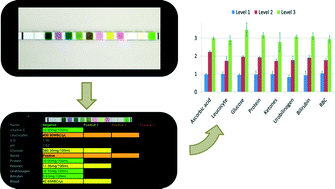Development of the smartphone-based colorimetry for multi-analyte sensing arrays†
Abstract
Here we report development of a smartphone app (application) that digitizes the colours of a colorimetric sensor array. A conventional colorimetric sensor array consists of multiple paper-based sensors, and reports the detection results in terms of colour change. Evaluation of the colour changes is normally done by the naked eye, which may cause uncertainties due to personal subjectivity and the surrounding conditions. Solutions have been particularly sought in smartphones as they are capable of spectrometric functions. Our report specifically focuses on development of a practical app for immediate point-of-care (POC) multi-analyte sensing without additional devices. First, the individual positions of the sensors are automatically identified by the smartphone; second, the colours measured at each sensor are digitized based on a correction algorithm; and third, the corrected colours are converted to concentration values by pre-loaded calibration curves. All through these sequential processes, the sensor array taken in a smartphone snapshot undergoes laboratory-level spectrometry. The advantages of inexpensive and convenient paper-based colorimetry and the ubiquitous smartphone are tied to achieve a ready-to-go POC diagnosis.


 Please wait while we load your content...
Please wait while we load your content...